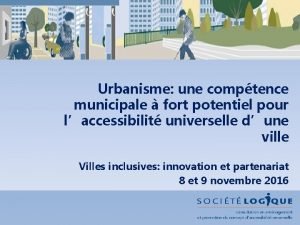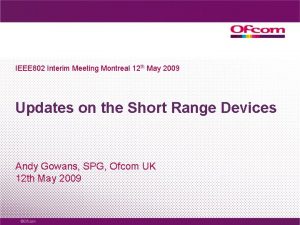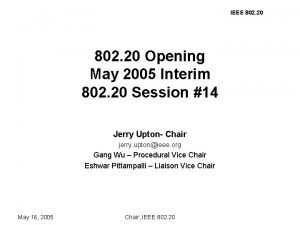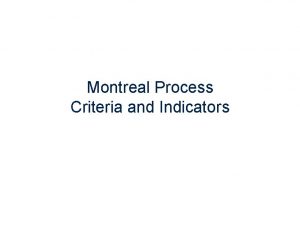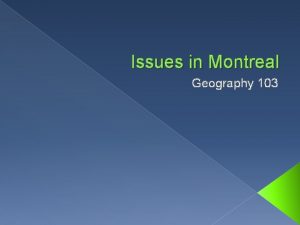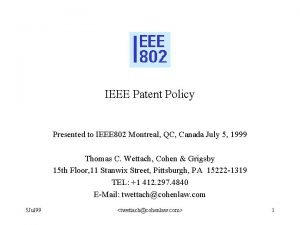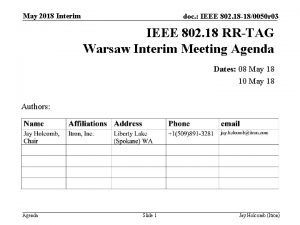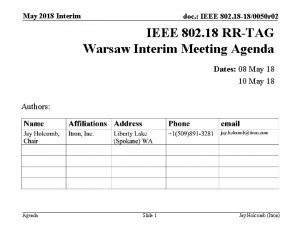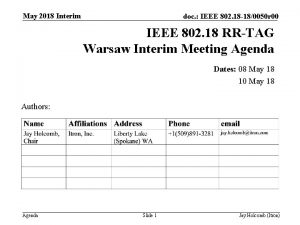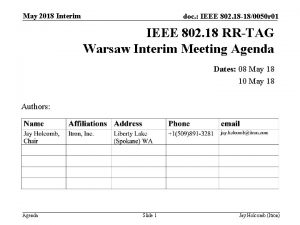IEEE 802 Interim Meeting Montreal 12 th May












- Slides: 12

IEEE 802 Interim Meeting Montreal 12 th May 2009 Updates on the digital dividend and UWB in the UK and Europe Andy Gowans, SPG, Ofcom UK 12 th May 2009

Contents • Digital Dividend – Cleared Spectrum – Cognitive Access • UWB – EC Decision – UK Consultation 1

UHF Bands IV and V – original UK plan* Channel Frequency (MHz) 112 MHz of cleared spectrum (14 8 MHz) 256 MHz of spectrum retained for DTT (32 8 MHz but interleaved capacity available within this) Channel 36 (used for airport radar) Channel 38 (used for radioastronomy) Channel 69 (used for programme-making and special events) * - new proposals to align with European plan currently being consulted upon 2

International and European developments • World Radiocommunication Conference 2007 – Primary mobile allocation for 790 -862 MHz in more Region 1 countries from 2009 – Primary mobile application for 790 -862 MHz in all Region 1 countries from 2015 • European Commission Communication on digital dividend – Proposed identification of common bands for clusters of similar networks – Did not address precise locations of those bands • CEPT band plan – 790 -862 MHz • RSPG Opinion on Cognitive Access • Developments in other European countries 3

Cleared spectrum: harmonised ECC technical conditions • Response to EC Mandate split into 3 parts by CEPT – Development of Protection Criteria for Broadcast and PMSE services – Development of Least Restrictive Technical conditions for ECS – Development of Appropriate Channel Plan (s) for ECS • Draft Response to the Mandate is to be discussed at the next ECC meeting (June 09) – TG 4 to develop Protection Criteria – PT 1 to develop Channel Plan (s) – SE 42 to develop Least Restrictive Technical Conditions • Current Status (May Change) – SE 42 are proposing BEM to represent the Technical Conditions – SE 42 also recommend 7 MHz guard space @ 790 MHz for TDD systems – PT 1 are proposing FDD plan, 1 MHz guard space @ 790 MHz 11 MHz Duplex Gap – PT 1 band plan not mandatory and to allow flexibility – Not all EC Countries are able to clear whole of 790 – 862 MHz • UK following results of ECC/EU work closely but still have all options open. 4

Current Cognitive Access studies in ECC/EC • RSPG are developing a report and an opinion on Cognitive Access including White Space • At their last meeting ECC set up : – A correspondence group to discuss general issues associated with CR – Instructed WGSE to start up studies looking at the technical issues associated with cognitive access to the White Space bands. • ETSI have set up a TG looking at issues associated with producing CR standards. • Netherlands Antillies have issued a condoc with proposals for managing their white Spaces • SE 42 and PT 1 work on cleared spectrum may have an impact on CR studies in Europe • UK have issued consultation on White Space but will input to and follow results of ECC/EU work closely but keep options open. 5

European studies and groups • ECC correspondence group and RSPG will look at the regulatory issues associated with implementing CR in the white spaces • Three approaches to cognitive access were suggested in the UK consultation – Sensing • This work is likely to be carried out in the new SE project team (SE 43) – Geolocation • New SE project team (SE 43) to take lead on technical studies • Not yet decided who will tackle regulatory and management issues – Beacons • New SE project team will take lead on technical studies. 6

Lots of further regulatory and standardisation work is still needed • Who hosts the database? • Who provides the information to populate it? • Who pays? • What protocols are adopted? • Exactly what information is submitted and returned? • Is there a need for international harmonisation? • And many others…. 7

It may take years to fully complete the process • This consultation closed at the end of April • Currently analysing responses • Depending on the responses, further consultation may be needed, particularly on geolocation • In parallel work at a European level to develop a harmonised approach – timescales unclear • In due course issue a Statement and Statutory Instrument (exempting cognitive devices from licensing) as appropriate • This timing is appropriate because – Caution is needed before allowing devices that might interfere – The industry is still some way from producing consumer devices 8

Contents • Digital Dividend – Cleared Spectrum – Cognitive Access • UWB – EC Decision – UK Consultation 9

European and UK developments for UWB • Amendments to the UWB decision 2007/131/EC were published on the 21/4/09. • Amendments to the previous EC Decision include: – The introduction of a new mitigation technique (TPC) and new limits to allow the use of UWB for both automotive and railway applications. – The introduction of a new mitigation technique DAA to enable higher power usage by UWB devices operating below 4. 8 GHz and above 8. 5 GHz. – The introduction of new limits for Building Material Analysis (BMA) devices. • ETSI still working on amendments to EN 302 065 v 1. 1. 1 which is the harmonised standard that covers short range UWB devices for communications applications operating in the frequency ranges from 3. 4 - 4. 8 GHz and 6 - 10. 5 GHz. Amendments to include tests and limits for TPC for automotive and railway applications and generic DAA mechanism. • EN 302 435 is the harmonised standard for Building Material Analysis (BMA) technologies. • Ofcom will publish a consultation very soon on how we intend to implement these changes in the UK law. 10

andrew. gowans@ofcom. org. uk











